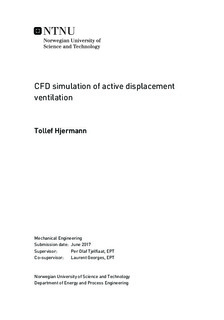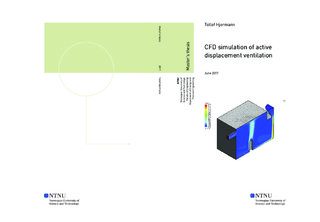| dc.description.abstract | Active displacement ventilation is an air supply method that reuses the warm and polluted air in the upper zone of the room for preheating, while sufficient indoor air quality and thermal comfort are still achieved in the zone of occupancy. Air with low temperature is supplied high on the wall with low velocity, and the air "falls" down to the lower zone due to buoyant effects. Well-designed active displacement ventilation has the potential of achieving thermal comfort and sufficient air quality with lower airflow rate and air temperature compared to displacement ventilation and mixing ventilation.
CFD has been used to investigate vertical low velocity buoyant and isothermal jets, both free and along walls, since these are of relevance in the design of active displacement ventilation. Furthermore, cases of active displacement in a simple room situation were simulated for different airflow rates and temperatures. Displacement ventilation and mixing ventilation were also investigated to create a basis for comparison.
In the investigation of jets, it was concluded that empirical relations and well-known jet theory for free jets, both buoyant and isothermal, correspond with the CFD simulations. Two turbulence models, RNG k-ε and Realizable k-ε, were used. When the vertical jets were moved next to a wall, it was observed that the maximum velocity was higher than for the free jets. As this result is contrary to what was expected it is assumed that the error lies in the CFD simulation. It is not clear to the author why the error occurred, but one hypothesis is that the k-ε models perform badly near walls.
For the room simulations, it is concluded that empirical relations together with heat- and mass balance are useful tools for the prediction of the airflow pattern, CO2 concentration, and temperature in a room with active displacement ventilation. One must be aware of the restrictions on the diffuser size and number of diffusers per wall width to use the relations in the area where they are valid. The most energy efficient solution was when a flow rate of 7 l/(s·person) with temperature 10˚C was supplied.
Displacement ventilation was in this thesis restricted to an inlet air temperature of 17˚C due to the risk of cold draught. Since the only heat loss from the room was through the ventilation duct, the flow rate for displacement ventilation had to be increased to 8 l/(s·person) to meet the requirement for thermal comfort. If the atmospheric environment was the only restriction, the flow rate could be reduced to 6 l/(s·person). Mixing ventilation was modelled as complete mixing ventilation, i.e. with homogenous CO2 concentration and air temperature. The most energy efficient solution was when the flow rate was 9 l/(s·person) and the air temperature was 11˚C. The methods were compared in a q0−Ti -chart to illustrate which combinations of flow rate and inlet air temperature that are suggested to use. | |

